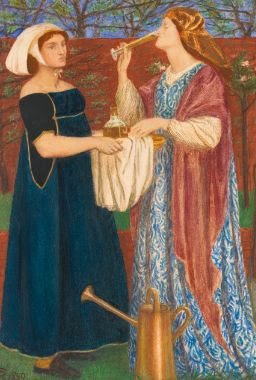Art influenced by the art and themes of the Pre Raphaelites with biographies, auctions and information on these artists.
Thursday, October 25, 2012
Dante Gabriel Rossetti - The Bower Garden
signed with monogram and dated 1859 l.l.
watercolour
36 by 25cm., 14 by 10in.
Royal Academy, 1883, no.367
In a secluded walled garden of raised flower-beds and espalier fruit-trees and clipped rose-bushes, a medieval lady has been watering flowers but stops momentarily to drink from a tall drinking vessel brought to her by a maid. Her richly embroidered costume and lofty mien indicates that she is a lady of importance whilst her attendant’s sombre smock and wimple denotes her more humble character. The same blue and white dress with scarlet lining had been painted by Rossetti in a remarkably violent watercolour of 1865 The Death of Breuze san Pitie (private collection) which had belonged to William Morris.
The Bower Garden is a beautiful example of Rossetti’s highly individual and influential pictures of the 1850s in which the flattened perspective, saturated colours and romantic whimsy were based upon early renaissance art and the courtly romance of medieval literature. Here the narrative is not specified but is implied by the expressions and gestures of the figures who symbolise cloistered sensuality and contrast luxury and servitude. The gesture of the woman drinking combines the sense of taste with the sight of visual beauty and in several of his pictures from this period Rossetti made similar parallels, usually with music and beauty (A Christmas Carol and The Tune of the Seven Towers and The Blue Closet).
Claustrophobic tension is created by the deliberate shallowness of the space, in which the raised flower-beds predict the parapets and window-frames of later pictures. The figures occupy most of the composition and demonstrate Rossetti’s talent for decorative design and his reimagining of early renaissance art, at this formative period in his career.
The model for the red-haired woman was the worshipped Pre-Raphaelite muse Elizabeth Siddall, the daughter of a cutler ‘discovered’ working in a south London milliners, who was famously painted by Millais in Ophelia of 1852 and became romantically involved with Rossetti around the same time. Although Lizzie and Gabriel were estranged in 1858 and part of 1859, the present picture perhaps embodies their renewed intimacy. They eventually married in Hastings on 23 May 1860. Walter Howell Deverell, who also painted Siddall, described her as ‘a stupendously beautiful creature like a queen, magnificently tall, with a lovely figure, a stately neck, and a face full of the most delicate and finished modelling.’ Here the glorious hue of her golden hair is emphasised by the lining of her gown and by the red-brick of the walled garden. The face of the maid is clearly recognisable as Rossetti’s earthy mistress Fanny Cornforth, illiterate and coarse but also gloriously beautiful, generous and loving. Fanny and Rossetti probably met late in 1857 (there are varying accounts of their first encounter) and The Bower Garden was one of Fanny’s earliest appearances in Rossetti’s art. She was the model for a similar painting Golden Water of 1858 (Tate) in which she has
a more exotic role as Princess Parisade from the Arabian Knights. It is believed that Fanny continued to be Rossetti’s mistress after his marriage (she also married around the same time) and the depiction of her as a serving-woman and Elizabeth as a Lady may have had a symbolic meaning to Rossetti, the ambiguous expression perhaps suggesting the secret held by Rossetti and Fanny of his infidelity. The Bower Garden was painted in the same year as another depiction of Fanny Bocca Baciata (Museum of Fine Arts, Boston) a small painting that heralded Rossetti’s series of luscious Titianesque canvases.
The first owner of The Bower Garden was Thomas Plint (1823-61), a woollen cloth manufacturer and reformer from Leeds. His collection included masterpieces by the Pre-Raphaelites, including Millais’ Christ in the House of his Parents, The Black Brunswicker and The Proscribed Royalist and Holman-Hunt’s Finding of the Saviour in the Temple . Plint owned Rossetti’s elaborate pen and ink drawings of Sir Lancelot in the Queen’s Chamber of 1857 (Birmingham City Art Gallery) and Hamlet and Ophelia (British Museum) and Mary Magdalene at the Door of Simon the Pharisee (Fitzwilliam Museum, Cambridge) both drawn in 1858, and the watercolours Carlisle Wall of 1853 (Ashmolean Museum, Oxford), a The Wedding of St. George and the Princess Sabra of 1857 (Tate).
The picture was bought after Plint’s death in 1861 by another famous Pre-Raphaelite patron, James Leathart (1820-1895) a wealthy lead manufacturer. He also owned Rossetti’s watercolours Sir Galahad at the Ruined Chapel (Birmingham City Art Gallery) and The Salutation of Beatrice (National Gallery of Canada) painted in the same year as The Bower Garden and at least half a dozen more pictures by him. The present picture has remained in the Leathart family until now.
http://www.sothebys.com/en/auctions/ecatalogue/2012/british-and-irish-art/lot.4.lotnum.html
Subscribe to:
Post Comments (Atom)

No comments:
Post a Comment